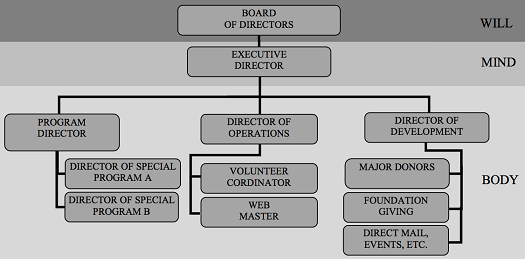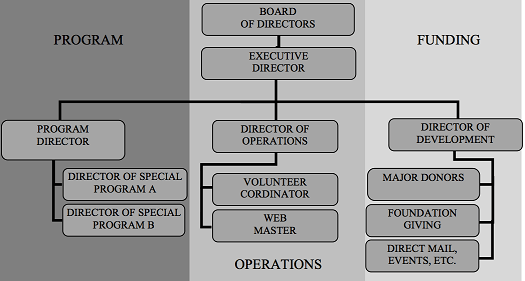Organizational Structure
 An organizational chart is a powerful tool that should be frequently studied in order to better understand how the organization is organized and deployed. Whether it is a staff of 3 or a staff of 300, the way an organizational chart is structured will influence the efficiency and effectiveness of the organization.
An organizational chart is a powerful tool that should be frequently studied in order to better understand how the organization is organized and deployed. Whether it is a staff of 3 or a staff of 300, the way an organizational chart is structured will influence the efficiency and effectiveness of the organization.
In this resource, we propose viewing the organizational chart in two ways: First, in horizontal bands that separate out the proper role of each board member, executive and staff. Second, in vertical bands that distinguishes between programming, operations and fundraising. This resource also outlines the proper roles of the Program Director, Director of Development, and Director of Operation positions.
Legal Parameters of The Nonprofit Organizational Chart
Nonprofit organizations should seek legal counsel to ensure their organizational chart is designed in compliance with the state law of which they are registered. For example, Wisconsin, New Jersey, and Illinois state statutes requires nonprofits to have a minimum of three Board of Directors at all times, with each serving at least a one-year term. While Wisconsin and Illinois do not have age requirements for these members, New York and New Jersey requires that they be 18 years of age or older.
Viewing the Organizational Chart Horizontally: The Will, Mind, Body
A successful nonprofit organization should view its organizational chart as containing three horizontal bands. Starting with the top, the Board of Directors who envision and direct the focus of the organization, guiding it’s movements with a very high level of strategic decision-making. The next layer, the executive gives shape and substance to the focus of the board, and finally, the staff layer is where the organization carries out the will of the Board in the plans of the executive.
To put it another way, the Board of Directors embodies the will of the agency as it guides the overall governance of the organization. The Executive Director, following the will, becomes the brains of mind of the organization, directing the body to achieve the will’s desires. Thus, the staff is the body that helps carry out the mission.
Unfortunately, many nonprofits lose focus and efficiency when these roles of become confused. For example, the Board of Directors might impute too much power to the Executive Director, placing the “will”, or the powers of focus and shaping the vision, onto the Executive. This can also happen when the Executive Director keeps the board weak, or when the Board abdicates their role through passivity or indifference.
At other times, the Board might overstep their role as high-level strategists, and try to get involved in the Executive’s role by outlining detailed plans for the carrying out of strategy. Some boards even go as far as crossing over into the staff’s role as “hands and feet” by becoming overly involved in day to day operations of the organization.
Lastly, staff can also fall prey to taking on the roles of the “mind” or “will” when they want to make strategic or tactical decisions beyond their purview. At the same time, there are many Executive Directors who see all three layers as their responsibility, and end up doing the work of the Board, the Executive and the Staff – and then wonder why they become burned out.
There is a very simple way to keep everyone in their proper roles. A clear and consistent process for a job performance review at every level will ensure that people are remaining within their zone. The Board should review the Executive at least once a year. The Executive should review staff at least once a quarter, if not monthly. The Board should also have very clear by- laws, which include term limits and job descriptions for each director position.
Viewing the Organizational Chart Vertically: Program, Operations, Funding
A successful nonprofit should also view its organizational chart as containing three vertical bands comprised of program, fundraising and operations.
- Program is the reason you exist, your primary mission.
- Fundraising is your revenue stream. No money, no mission.
- Operations are all of the administrative tasks that are essential to running an organization.
A vertical organizational chart can be therefore seen as the following:

Note that in a smaller nonprofit of only 3 people, for example, the Executive Director would likely be the fundraiser, while the Program Director keeps the programs going, and the Administrative Assistant takes care of the operations. In larger organizations there can be multiple layers, but it usually breaks down into these three areas.
Program Director
While the Executive Director ensures a smooth flow of all the various aspects of the organization, the Program Director focuses on one specific program. In larger nonprofit organizations there may be more than one Program Director to ensure that the mission is fully achieved. The general roles of a Program Director include:
- Develop and implement the organization’s program(s).
- Ensure program needs are analyzed and met.
- Coordinate the activities of sub-committees orientated around the program(s).
- Create program reports for Executive Director presentation
In working with the Board of Directors, the Executive Director ensures entire organizational priorities are being met while the Program Director presents the organization through various events and activities. With assistance of the Executive Director, the Program Director should also lead various sub-committees of the Board that work directly with the execution of his/her program.
Director of Development
The Director of Development creates the revenue stream the organization cannot get from its constituents by securing funds from major donors, individuals, and foundations. The Fundraising Director must:
- Develop and execute a fundraising strategy.
- Increase funding from individuals and major donors.
- Support grant writing department in obtaining foundation funding.
- Formalize fundraising reports for Executive Director presentation.
The Director of Development has the invaluable duty of cultivating relationships with all the funding sources to ensure future cash flow while also developing new sources. As the organization could not exist without funding opportunities, this role is an essential to achieve the mission.
Director of Operations
The Director of Operations oversees the daily operations of the entire organization. While the Program and Development Directors have more specialized areas of focus involving programs and funding, the Director of Operations’ role is no light task. The responsibilities of this role often include:
- Performing Human Resource functions including overseeing policies, staff training, and evaluations.
- Coordinates staff involvement; both paid positions as well as volunteer recruitment.
- Oversees all legal agreements involving equipment, insurance, and vendors.
- Supervise staff involved in financial department involving budgeting, payroll, and all financial reports produced.
- Various administrative duties; travel arrangements, research, and partnership correspondence.
The Director of Operations ensures a smooth existence of the organization in its entirety through the use of various sub-divisions such as the Human Resources department, the Finance/Payroll department, and other administrative duties. This position requires direct correspondence with the Executive Director, Program, and Development Directors in an effort to meet and predict any needs of the whole organization.
Regardless as to the size of the organization, healthy and frequent communication between the different layers of the organizational chart is essential to the efficient and effective carrying out of the mission. Leadership must therefore think about and operate the organization in terms of the division of labor with its roles and responsibilities. As with any change to the organization, a structural change will only be successful if it is consistently applied at the informal level of interpersonal relationships and social expectations.
Articles for Further Reading
- Human Resources Management. The Management Library website holds a magnitude of resources regarding choosing staff to evaluating staff for nonprofit organizations. http://managementhelp.org/hr_mgmnt/hr_mgmnt.htm
- Job Description Samples. This article lists the definition and duties of the more common positions within a nonprofit organization. http://www.delawarenonprofit.org/toolstemplates/samplejob.php
- Hiring a Director for a Nonprofit Agency: A Step-by-Step Guide. This article provides great advice for organizations looking to hire or replace an Executive Director. http://www.sog.unc.edu/pubs/electronicversions/pg/pgsum00/article4.pdf
For more information, please visit the Giersch Group at www.gierschgroup.com or contact us at prosper@gierschgroup.com.
